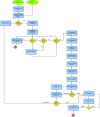Improved FMEA Methods for Proactive Health Care Risk Assessment of the Effectiveness and Efficiency of COVID-19 Remote Patient Telemonitoring
- PMID: 36250651
- PMCID: PMC9622365
- DOI: 10.1097/JMQ.0000000000000089
Improved FMEA Methods for Proactive Health Care Risk Assessment of the Effectiveness and Efficiency of COVID-19 Remote Patient Telemonitoring
Abstract
The COVID-19 pandemic exposed the need to more effectively harness and leverage digital tools and technology for remote patient monitoring (RPM). RPM gained great popularity given the need to provide effective, safe, efficient, and remote patient care. RPM is based on noninvasive digital technologies aimed at improving the safety and efficiency of health care delivery. We report on an RPM program in which 200 COVID-19 patients were followed remotely to evaluate the effectiveness in treating and monitoring patients in home settings. We analyzed the inherent risks using mixed methods, including failure mode and effect analysis, a prospective, team-based risk management methodology structured to identify high-risk process system failures before they occur in telemonitoring of remote patients. The RPM saved lives and improved decision-making during the pandemic and helped prevent the health system's collapse. The failure mode and effect analysis-based assessment offers important insights and considerations for evaluating future RPM implementation and direction. RPM solutions are technically feasible, staff friendly, and can achieve high adherence rates. Rigorous and ongoing evaluation of devices and platforms is essential to clarifying their value and guiding national health and insurance health coverage decisions and adoption programs.
Copyright © 2022 the American College of Medical Quality.
Conflict of interest statement
The authors have no conflicts of interest to disclose.
Figures
References
-
- Tuckson RV, Edmunds M, Hodgkins ML. Telehealth. N Engl J Med 2017;377:1585–1592. doi:10.1056/NEJMsr1503323. - PubMed
-
- Nouri S, Khoong EC, Lyles CR, et al. Addressing equity in telemedicine for chronic disease management during the Covid-19 pandemic. N Engl J Med 2020;1:1–12.
-
- Gandy K, Schmaderer M, Szema A, et al. A promising digital health frontier. International Conference IDT 2021:297–302. https://digital-strategy.ec.europa.eu/en/library/communication-enabling-.... Accessed April 25, 2018.
MeSH terms
LinkOut - more resources
Full Text Sources
Medical



